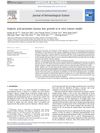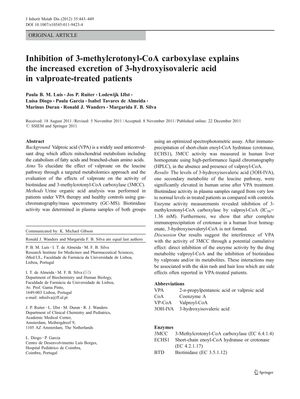TLDR Valproic acid treatment increases a specific acid in urine by blocking an enzyme, possibly causing skin rash and hair loss.
The study investigated the impact of valproic acid (VPA), an anticonvulsant drug, on mitochondrial metabolism, specifically the leucine pathway, by comparing urine samples from VPA-treated patients to those from healthy controls using gas-chromatography/mass spectrometry. It was found that 3-hydroxyisovaleric acid levels were significantly higher in the urine of patients treated with VPA. Additionally, biotinidase activity in plasma samples showed a range from very low to normal in treated patients compared to controls. The study also demonstrated that valproyl-CoA, a metabolite of VPA, directly inhibits the activity of 3-methylcrotonyl-CoA carboxylase (3MCC) with an IC(50) of 1.36 mM. The inhibition of 3MCC and biotinidase by VPA and its metabolites may contribute to the side effects of skin rash and hair loss often reported by patients undergoing VPA treatment.
16 citations
,
May 2009 in “Journal of child neurology” Valproic acid does not change biotinidase enzyme activity in children's blood.
36 citations
,
October 2008 in “European journal of paediatric neurology” Valproic acid treatment may cause temporary hair loss due to reduced zinc and biotinidase levels, which tend to normalize after 6 months.
22 citations
,
September 2008 in “Brain & development” Biotin supplements increased biotin levels but did not significantly prevent hair loss in rats on valproic acid.
15 citations
,
May 2006 in “Brain & development” Valproic acid may cause hair loss by reducing biotinidase enzyme activity in rats.
73 citations
,
October 2001 in “Epilepsia” Children taking higher doses of valproic acid had lower biotinidase activity, which may lead to biotin deficiency, but biotin supplements could help.
 38 citations
,
September 1996 in “Annals of Clinical Psychiatry”
38 citations
,
September 1996 in “Annals of Clinical Psychiatry” Hair loss from mood stabilizers is common but can be managed without stopping the medication.
 47 citations
,
March 2019 in “Journal of immunology research”
47 citations
,
March 2019 in “Journal of immunology research” Valproic Acid could potentially be used to treat immune-related conditions due to its ability to modify immune cell functions.
 68 citations
,
March 2018 in “Biomaterials”
68 citations
,
March 2018 in “Biomaterials” Tiny needles with valproic acid can effectively regrow hair.
15 citations
,
May 2006 in “Brain & development” Valproic acid may cause hair loss by reducing biotinidase enzyme activity in rats.
 November 2024 in “Journal of Cosmetic Dermatology”
November 2024 in “Journal of Cosmetic Dermatology” Valproic acid microemulsions improve skin delivery compared to regular solutions.
 48 citations
,
June 2013 in “Journal of Dermatological Science”
48 citations
,
June 2013 in “Journal of Dermatological Science” Valproic acid may help hair grow and could be a safe treatment for hair loss.





